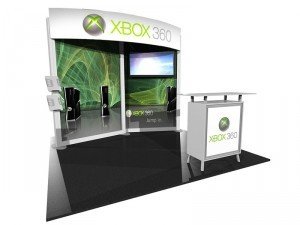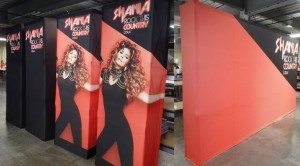Exhibiting 101: How To Buy A New Exhibit
This is the third in a series of articles about the basics of exhibiting that began with the first post of the New Year.
There are usually two big choices in the career of a trade show manager: (1) buying the company’s first trade show exhibit, and (2) buying the next booth.
This article will help guide you through the process of successfully negotiating the best deal for your first—or next—new booth. It will also save you time, trouble and headaches along the way.
Let’s start with a few steps to steer your thinking, whether you’re about to buy your first exhibit, or you’ve been purchasing booths for years. Get your team together and answer these questions:
1) Who are we?
This may seem simplistic, but you (and the rest of the people involved in this decision making process) need to be very clear about how you want to define your company to show attendees. An exhibit can communicate this message in subtle ways, with the choices in colors and finishes creating a feeling for visitors.
Your graphics will further emphasize this feeling. A booth’s design can also miscommunicate who you are, so tread carefully.
2) What do we want?
What are you trying to accomplish? Maybe it’s rebranding your company, garnering more sales or staking out a position for your company in the marketplace. Make sure your booth supports that message.
3) Who do you want to talk to?
Not every attendee is a prospect, so your booth should help you attract those who are.
Everything from your color palette to your graphics play a part in sifting through all those people on the show floor and finding those you want to speak to.
Ideally, that combination of attractive elements will be memorable long after the show, when your sales department is following up with leads.
Now that you have a better understanding of what you want your booth to communicate, and how you want to accomplish that, you can move on to…
Buying Your First Exhibit:
For a trade show manager, this process is like planning a wedding: many people have opinions and dozens of them want a say in the decision.
And, like a wedding plan, many of those opinions are at odds with each other. That means you have to sort it all out.
But when the big day happens, the important thing is that everything goes according to plan. For your trade show display, that means it does what it’s supposed to do: attract attention, educate attendees and move the sales process forward. That way, everyone is happy.
So how do you decide what to buy?
A key choice is between traditional trade show displays and modular display units.
In the old days, modular displays looked like what they were: individual pieces put together like Lego bricks or Tinker Toys to create a booth.
Today, the designs that can be created with modular display units are virtually limitless. Components are available in countless shapes, sizes, finishes and colors.
Customizable modular displays make it easy to update your look whenever you want, by rearranging the components, changing graphic panels or introducing new elements. With a typical tradeshow display layout, major changes are more challenging, because traditional exhibits aren’t designed to be updatable.
You’ll also want to consider costs when deciding between these two exhibit types. And costs don’t end when construction is complete. Custom displays always need to be set up and dismantled by union labor that you supervise.
Many modular booths can be assembled and taken down by your own staff, saving you time and money with every show.
Another major cost you’ll encounter is shipping. Crated exhibits can weigh thousands of pounds and take up lots of room in your shipping company’s truck. You pay for that weight and space every time your booth is transported. And then you’ll pay for that weight as a drayage fee at the show!
Conversely, a modular exhibit usually packs more efficiently, resulting in fewer, smaller and lighter crates, again saving you money at each show.
It can be very beneficial to attend several shows and take pictures of exhibits that you think would work well for your company. Take note of what your competitors are doing and commit to creating something better.
When “secret shopping” your competition like this, don’t be dazzled by expensive or impractical exhibit structures that won’t suit your needs. Look for designs or approaches that will lend themselves to your company’s requirements. There are some very nice eco-friendly displays to convey your environmental concerns or match your own eco-friendly products.
With this knowledge in mind, consider inviting companies who specialize in both types of exhibits to present you with their ideas for your exhibit program. Each approach to exhibit fabrication has its positives and negatives.
Ultimately, it’s your decision which approach is right for your company.
Buying Your Next Exhibit:
How do you know when it’s time to invest in a new exhibit?
One big sign could be that, in addition to the connecting hardware that originally came with your booth, you’ve also been using duct tape and cable ties to hold the thing together for a while.
It can also be time for something new when your company’s marketing message or focus has changed, or when your booth begins to look outdated.
Nothing turns off trade show attendees as much as a tired looking exhibit. On the other hand, nothing excites attendees as much as something new and different.
When these unfortunate things are happening, or simply when you think show attendees aren’t paying attention to your company because they feel they’ve seen your booth many times before, it’s time for a change.
But just because your exhibit has clocked a lot of mileage on the trade show circuit doesn’t mean it’s worthless.
Your old booth can be sold to another company (who can refurbish it), bartered with your new exhibit builder (who might be able to resell it or add it to rental inventory), or donated to a charity.
This is a chance to upcycle, rather than toss it away.
Whether you’re purchasing your first trade show display or the next in a long line of successful booths, American Image Displays can assist you in making the right choice.
To discuss your needs with someone with the knowledge and experience to help, call (800) 676-3976 or email [email protected].
For more, check out our article on how to pick the right show or how to patch holes in your budget.
See full list of Exhibiting 101 articles here.



